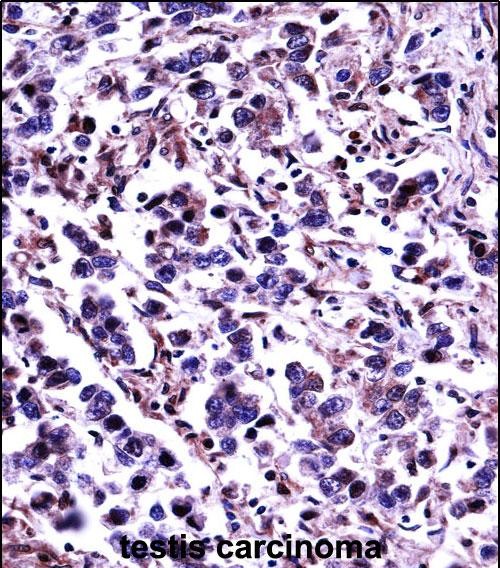CAPN11 Antibody (Center)
Affinity Purified Rabbit Polyclonal Antibody (Pab)
- SPECIFICATION
- CITATIONS
- PROTOCOLS
- BACKGROUND

Application
| IHC-P, WB, E |
|---|---|
| Primary Accession | Q9UMQ6 |
| Other Accession | NP_008989.2 |
| Reactivity | Human |
| Host | Rabbit |
| Clonality | Polyclonal |
| Isotype | Rabbit IgG |
| Calculated MW | 84423 Da |
| Antigen Region | 409-438 aa |
| Gene ID | 11131 |
|---|---|
| Other Names | Calpain-11, 3422-, Calcium-activated neutral proteinase 11, CANP 11, CAPN11 |
| Target/Specificity | This CAPN11 antibody is generated from rabbits immunized with a KLH conjugated synthetic peptide between 409-438 amino acids from the Central region of human CAPN11. |
| Dilution | IHC-P~~1:10~50 WB~~1:1000 E~~Use at an assay dependent concentration. |
| Format | Purified polyclonal antibody supplied in PBS with 0.09% (W/V) sodium azide. This antibody is purified through a protein A column, followed by peptide affinity purification. |
| Storage | Maintain refrigerated at 2-8°C for up to 2 weeks. For long term storage store at -20°C in small aliquots to prevent freeze-thaw cycles. |
| Precautions | CAPN11 Antibody (Center) is for research use only and not for use in diagnostic or therapeutic procedures. |
| Name | CAPN11 |
|---|---|
| Function | Calcium-regulated non-lysosomal thiol-protease which catalyzes limited proteolysis of substrates involved in cytoskeletal remodeling and signal transduction. |
| Cellular Location | Cytoplasmic vesicle, secretory vesicle, acrosome |
| Tissue Location | Highest expression in testis. |

Thousands of laboratories across the world have published research that depended on the performance of antibodies from Abcepta to advance their research. Check out links to articles that cite our products in major peer-reviewed journals, organized by research category.
info@abcepta.com, and receive a free "I Love Antibodies" mug.
Provided below are standard protocols that you may find useful for product applications.
Background
Calpains constitute a family of intracellular calcium-dependent cysteine proteases. There are eight members in this superfamily. They consist of a variable 80 kDa subunit and an invariant 30 kDa subunit. This calpain protein appears to have protease activity and calcium-binding ability. A similar mouse protein may play a functional role in spermatogenesis and in the regulation of calcium-dependent signal transduction events during meiosis.
References
Ben-Aharon, I., et al. Mol. Reprod. Dev. 73(6):767-773(2006)
Dear, T.N., et al. Genomics 59(2):243-247(1999)
Rojas, F.J., et al. Mol. Hum. Reprod. 5(6):520-526(1999)
Saido, T.C., et al. FASEB J. 8(11):814-822(1994)
Melloni, E., et al. Trends Neurosci. 12(11):438-444(1989)
If you have used an Abcepta product and would like to share how it has performed, please click on the "Submit Review" button and provide the requested information. Our staff will examine and post your review and contact you if needed.
If you have any additional inquiries please email technical services at tech@abcepta.com.













 Foundational characteristics of cancer include proliferation, angiogenesis, migration, evasion of apoptosis, and cellular immortality. Find key markers for these cellular processes and antibodies to detect them.
Foundational characteristics of cancer include proliferation, angiogenesis, migration, evasion of apoptosis, and cellular immortality. Find key markers for these cellular processes and antibodies to detect them. The SUMOplot™ Analysis Program predicts and scores sumoylation sites in your protein. SUMOylation is a post-translational modification involved in various cellular processes, such as nuclear-cytosolic transport, transcriptional regulation, apoptosis, protein stability, response to stress, and progression through the cell cycle.
The SUMOplot™ Analysis Program predicts and scores sumoylation sites in your protein. SUMOylation is a post-translational modification involved in various cellular processes, such as nuclear-cytosolic transport, transcriptional regulation, apoptosis, protein stability, response to stress, and progression through the cell cycle. The Autophagy Receptor Motif Plotter predicts and scores autophagy receptor binding sites in your protein. Identifying proteins connected to this pathway is critical to understanding the role of autophagy in physiological as well as pathological processes such as development, differentiation, neurodegenerative diseases, stress, infection, and cancer.
The Autophagy Receptor Motif Plotter predicts and scores autophagy receptor binding sites in your protein. Identifying proteins connected to this pathway is critical to understanding the role of autophagy in physiological as well as pathological processes such as development, differentiation, neurodegenerative diseases, stress, infection, and cancer.



